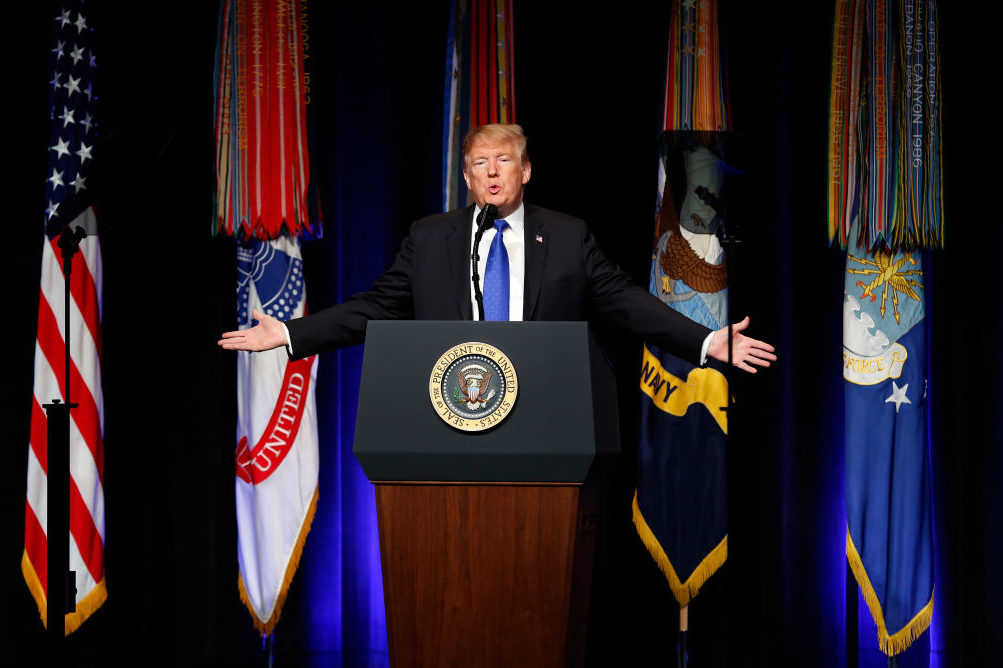The Pentagon is urgently reviewing just how and when the president might launch nuclear missiles as a dangerous new nuclear arms race breaks out.
Hypersonic missiles are capable of flying at around 12,000 miles per hour, or Mach 20. That would reduce the US response time to as little as five minutes — too short for the president to enter the launch codes into the ‘football’ (actually a briefcase) that is never more than a few feet away.
Instead, some officials argue that Artificial Intelligence should manage the US response. AI could gather information about launches, likely targets, and the most effective counter-responses — and be empowered to launch nuclear missiles without human intervention. The dilemma for Pentagon planners is that relying on technology to decide the fate of humanity is a high-risk solution that has been shown to fail in the past.
Two Cold War incidents underline just how important humans are in the nuclear command chain. In 1983, shortly after the Soviets shot down Korean Airlines 007, the Soviet air defense system detected the launch of a single Intercontinental Ballistic Missile from an underground silo in North Dakota. The launch was swiftly followed by five more. At the time, Soviet doctrine embraced the LOW (Launch on Warning) doctrine, which meant that a retaliatory strike would be in the air before the first US missile struck Soviet soil.
Lt.Col. Stanislav Petrov was the duty commander of the Soviet early warning system on that September day. He was meant to report the launch to the Moscow high command, who would only have had a few minutes to issue orders for a retaliatory strike. But Petrov had been trained to expect that an American first strike would involve the launch of hundreds of missiles from land, sea and air. Six missiles seemed too few for a first strike. Second, his command had recently installed a new radar detection system, and Petrov did not believe it was fully operational. So he chose not to pass the alert up the chain of command and instead put the incident down to a false alarm.
Later investigation proved him right. It turned out that unusual reflections of sunlight upon clouds above North Dakota had bounced an image to a circling Soviet satellite, which had interpreted the reflections as the flares from missile launches.
Two months later, NATO practiced an exercise codenamed Able Archer. Russia’s Politburo had become increasingly nervous about American intentions after President’s Reagan’s talk of an ‘Evil Empire’. They believed the exercise was a cover for a first strike. Oleg Gordievsky, an MI6 spy in the KGB, passed increasingly alarmist reports back to London that a paranoid Russian leadership were preparing to launch a nuclear first strike. After some frantic diplomacy, the crisis was averted. Both Reagan and Britain’s prime minister Margaret Thatcher turned down their rhetoric, to avoid any further misunderstanding.
Even with humans in the nuclear release loop, there are no reliable methods for shooting down a hypersonic missile. Instead, the only counter will be a massive strike. This may sound similar to the MAD (Mutually Assured Destruction) doctrine that has kept an uneasy nuclear peace for decades. But hypersonic missiles will render the MAD doctrine obsolete within the next five years.
This partly explains why the hypersonic arms race is soaking up billions of dollars in the US, China, Russia, Japan, France and India. Both Russia and China claim to have already developed working hypersonic missiles. President Putin has boasted of his country’s new capability, claiming that the new missiles could reach the American mainland in under five minutes. Western intelligence agencies are highly skeptical of the Russian and Chinese claims. They suspect that research and testing is well advanced, but actual deployment may be some years away.
The United States is still researching a conventionally-armed hypersonic missile and claims it has no plans to deploy hypersonic nuclear missiles. Ironically, there may be no need to do so, because the speeds at which a hypersonic missile will hit its target is enough to penetrate any known bunker, missile defense or armor plating.
When a foreign power deploys hypersonic missiles, much of American missile defenses will become obsolete. A hypersonic missile could bypass the defenses of a US carrier battle group and destroy the aircraft carrier. American missiles could be destroyed by precise hypersonic attack while still in their silos.
Insight into current American thinking came earlier this month when the Pentagon mistakenly published its Doctrine for Joint Nuclear Operations online before hurriedly taking it down.
‘The spectrum of nuclear warfare may range from tactical application, to limited regional use, to global employment by friendly forces and/or enemies,’ said the document. ‘Employment of nuclear weapons can radically alter or accelerate the course of a campaign. A nuclear weapon could be brought into the campaign as a result of perceived failure in a conventional campaign, potential loss of control or regime, or to escalate the conflict to sue for peace on more-favorable terms.’
In other words, the use of nuclear weapons should not be confined to a massive exchange with a country like Russia or China. Instead nuclear strikes can be used in a limited tactical way, to achieve objectives that could also be achieved by conventional fighting.
The US received much criticism for what some said was a new and much more aggressive Trump nuclear doctrine. In fact, there has been no real change. Nuclear weapons have always been designed to play a part in the Pentagon’s war plans. The challenge now is not so much American nuclear doctrine, but just how America and its allies will be able to counter the runaway development of hypersonic missiles.
The successful deployment of hypersonic missiles is now a certainty. Relying on technological solutions to manage a future nuclear exchange seems like folly. Yet the potential hypersonic powers are not in talks about limiting the deployment or use of hypersonic missiles. Instead, the new arms race continues to gather speed. As of now, tomorrow’s hypersonic powers have no plans to even talk about the escalating risks of global war.


















